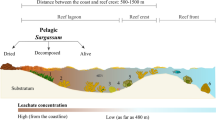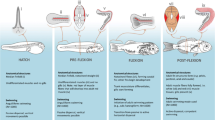Abstract
This study describes an image analysis method that has been used to analyze the swimming behavior of native oyster D-larvae (Crassostrea gigas) from the Arcachon Bay (SW, France). In a second time, this study evaluated the impact of copper and S-metolachlor pollutants on D-larvae swimming activity and the possible relationship between developmental malformations and abnormal swimming behavior. Analyses in wild and cultivated oyster D-larvae were investigated during two breeding-seasons (2014 and 2015) at different sampling sites and dates. In controlled conditions, the average speed of larvae was 144 μm s−1 and the maximum speed was 297 μm s−1 while the trajectory is mainly rectilinear. In the presence of environmental concentration of copper or S-metolachlor, no significant difference in maximum or average larval speed was observed compared to the control condition but the percentage of circular trajectory increased significantly while the rectilinear swimming larvae significantly declined. The current study demonstrates that rectilinear trajectories are positively correlated to normal larvae while larvae with shell anomalies are positively correlated to circular trajectories. This abnormal behavior could affect the survival and spread of larvae, and consequently, the recruitment and colonization of new habitats.







Similar content being viewed by others

References
AFNOR XP T90-382 (2009) Qualité de l'eau - Bio indicateur de la toxicité potentielle de milieux aqueux - Détermination de la toxicité potentielle d'échantillons aqueux sur le développement embryo-larvaire de bivalve. p. 19
Auby I, Bocquene G, Quiniou F, Dreno JP (2007) Etat de la contamination du Bassin d’Arcachon par les insecticides et les herbicides sur la période 2005-2006. Impact Environn 24:108 http://archimer.ifremer.fr/doc/00000/2398/
Auby I, Maurer D, Passoni S, Heroin D, Rigouin L, Méteigner C, Perrière-Rumèbe M, Tournaire M-P (2014) Reproduction de l’huître creuse dans le Bassin d'Arcachon Année 2014. Ifremer 55. https://www.researchgate.net/publication/271765196
Caldwell CA, Jacobi GZ, Anderson MC, Parmenter RR, McGann J, Gould WR, DuBey R, Jacobi MD (2013) Prescribed-fire effects on an aquatic community of a Southwest Montane Grassland System. N Am J Fish Manag 33(5):1049–1062
Chevalier J, Harscoët E, Keller M, Pandard P, Cachot J, Grote M (2015) Exploration of Daphnia behavioral effect profiles induced by a broad range of toxicants with different modes of action. Environ Toxicol Chem 34:1760–1769
Faimali M, Gambardella C, Costa E, Piazza V, Morgana S, Estevez-Calvar N, Garaventa F (2017) Old model organisms and new behavioral end-points: swimming alteration as an ecotoxicological response. Mar Environ Res 128:36–45
FAO (2019) Fisheries and aquaculture Department. Fish Stat Crassostrea gigas (Thunberg, 1793). http://www.fao.org/fishery/species/3514/
Festa RA, Thiele DJ (2011) Copper: an essential metal in biology. Curr Biol 21:R877–R883
Flemming CA, Trevors JT (1989) Copper toxicity and chemistry in the environment: a review. Water Air Soil Pollut 44:143–158
Gamain P, Gonzalez P, Cachot J, Pardon P, Tapie N, Gourves PY, Budzinski H, Morin B (2016) Combined effects of pollutants and salinity on embryo-larval development of the Pacific oyster, Crassostrea gigas. Mar Environ Res 113:31–38
Gamain P, Gonzalez P, Cachot J, Clérandeau C, Mazzella N, Gourves P-Y, Morin B (2017a) Combined effects of temperature and copper and S-metolachlor on embryo-larval development of the Pacific oyster, Crassostrea gigas. Mar Pollut Bull 115:201–210
Gamain P, Cachot J, Gonzalez P, Budzinski H, Gourves P-Y, Morin B (2017b) Do temporal and spatial parameters or lifestyle of the Pacific oyster Crasssostrea gigas affect pollutant bioaccumulation, offspring development and tolerance to pollutants? Front Mar Sci 4:58. https://doi.org/10.3389/fmars.2017.00058
Garaventa F, Gambardella C, Di Fino A, Pittore M, Faimali M (2010) Swimming speed alteration of Artemia sp. and Brachionus plicatilis as a sub-lethal behavioural end-point for ecotoxicological survey. Ecotoxicology 19:512–519
Handy RD, Sims DW, Giles A, Campbell HA, Musonda MM (1999) Metabolic trade-off between locomotion and detoxification for maintenance of blood chemistry and growth parameters by rainbow trout (Oncorhynchus mykiss) during chronic dietary exposure to copper. Aquat Toxicol 47:23–41
His E, Beiras R, Seaman MNL (1999) The assessment of marine pollution bioassays with bivalve embryos and larvae. Adv Mar Biol 37:1–178
Horiguchi T, Imai T, Cho HS, Shiraishi H, Shibata Y, Morita M, Shimizu M (1998) Acute toxicity of organotin compounds to the larvae of the rock shell, Thais clavigera, the disk abalone, Haliotis discus discus and the giant abalone, Haliotis madaka. Mar Environ Res 46:469–473
Kapur JN, Sahoo PK, Wong AKC (1985) A new method for gray-level picture thresholding using the entropy of the histogram. Computer Vis Graph Image Process 29:273–285
Kazlauskiene N, Svecevičius G, Petrauskiene L, Vosyliene MZ (2010) Behavioural responses of medicinal leech and rainbow trout exposed to crude oil and heavy fuel oil in ontogenesis. Pol J Environ Stud 19:429–433
Kokkali V, Katramados I, Newman JD (2011) Monitoring the effect of metal ions on the mobility of Artemia salina Nauplii. Biosensors 1:36–45
Kwok CK, Ang PO (2013) Inhibition of larval swimming activity of the coral (Platygyra acuta) by interactive thermal and chemical stresses. Mar Pollut Bull 74:264–273
LaBreche TMC, Dietrich AM, Gallagher DL, Shepherd N (2002) Copper toxicity to larval Mercenaria mercenaria (hard clam). Environ Toxicol Chem 21:760–766
Le Bihanic F, Sommard V, de Lansalut P, Anaïk P, Grasset J, Berrada S, Budzinski H, Cousin X, Morin B, Cachot J (2015) Environmental concentrations of benz[a]anthracene induce developmental defects and DNA damage and impair photomotor response in Japanese medaka larvae. Ecotox Environ Safe 113:321–328
Legendre P, Legendre L (1998) Numerical ecology. Transformation:1–4
Lissalde S, Mazzella N, Fauvelle V, Delmas F, Mazellier P, Legube B (2011) Liquid chromatography coupled with tandem mass spectrometry method for thirty-three pesticides in natural water and comparison of performance between classical solid phase extraction and passive sampling approaches. J Chromatogr A 1218(11):1492–1502
Lv Z, Tek A, Da Silva F, Empereur-mot C, Chavent M, Baaden M (2013) Game on, science - how video game technology may help biologists tackle visualization challenges. Plos One. https://doi.org/10.1371/journal.pone.0057990
Mai H, Cachot J, Brune J, Geffard O, Belles A, Budzinski H, Morin B (2012) Embryotoxic and genotoxic effects of heavy metals and pesticides on early life stages of Pacific oyster (Crassostrea gigas). Mar Pollut Bull 64:2663–2670
Mai H, Morin B, Pardon P, Gonzalez P, Budzinski H, Cachot J (2013) Environmental concentrations of irgarol, diuron and S-metolachlor induce deleterious effects on gametes and embryos of the Pacific oyster, Crassostrea gigas. Mar Environ Res 89:1–8
Martin JM, Saaristo M, Bertram MG, Lewis PJ, Coggan TL, Clarke BO, Wong BBM (2017) The psychoactive pollutant fluoxetine compromises antipredator behaviour in fish. Environ Pollut 222:592–599
McCallum ES, Krutzelmann E, Brodin T, Fick J, Sundelin A, Balshine S (2017) Exposure to wastewater effluent affects fish behaviour and tissue-specific uptake of pharmaceuticals. Sci Total Environ 605-606:578–588
Melvin SD, Wilson SP (2013) The utility of behavioral studies for aquatic toxicology testing: a meta-analysis. Chemosphere 93:2217–2223
Mileikovsky SA (1973) Speed of active movement of pelagic larvae of marine bottom invertebrates and their ability to regulate their vertical position. Mar Biol 23:11–17
Morgana S, Gambardella C, Falugi C, Pronzato R, Garaventa F, Faimali M (2016) Swimming speed alteration in the early developmental stages of Paracentrotus lividus sea urchin as ecotoxicological endpoint. Mar Environ Res 115:11–19
Nussbaum-Krammer CI, Neto MF, Brielmann RM, Pedersen JS, Morimoto RI (2015) Investigating the spreading and toxicity of prion-like proteins using the metazoan model organism C. elegans. J Vis Exp (95):e52321
Scott GR, Sloman KA (2004) The effects of environmental pollutants on complex fish behaviour: integrating behavioural and physiological indicators of toxicity. Aquat Toxicol 68:369–392
Sommers F, Mudrock E, Labenia J, Baldwin D (2016) Effects of salinity on olfactory toxicity and behavioral responses of juvenile salmonids from copper. Aquat Toxicol 175:260–268
Suquet M, Le Mercier A, Rimon F, Mingant C, Haffray P, Labbe C (2012) Setting tools for the early assessment of the quality of thawed Pacific oyster (Crassostrea gigas) D-larvae. Theriogenology 78:462–467
Suquet M, Rimond F, Cosson J, Wilson-Leedy J, Lebrun L, Queau I, Mingant C, Fauve C (2013) Effect of age and environmental conditions on the movement characteristics of Pacific oyster (Crassostrea gigas) trochophores. J Appl Ichthyol 29:1145–1148
Tapie N, Chevance DL, Budzinski H (2017) Repar pesticides : quantification de la présence dans les eaux, année 2012, 22 p. https://www.siba-bassin-arcachon.fr/actions-environnementales/bibliotheque-environnementale/repar-quantification-de-la-presence-dans-les-eaux
Troost K, Veldhuizen R, Stamhuis EJ, Wolff WJ (2008) Can bivalve veligers escape feeding currents of adult bivalves? J Exp Mar Biol Ecol 358:185–196
Turner A (2010) Marine pollution from antifouling paint particles. Mar Pollut Bull 60:159–171
Van der Schalie WH, Shedd TR, Knechtges PL, Widder MW (2001) Using higher organisms in biological early warning systems for real-time toxicity detection. Biosens Bioelectron 16:457–465
Acknowledgments
The authors thank the Aquitaine Region (OSQUAR Project), CPER A2E, Intermunicipal Union of Arcachon Bay (SIBA) and Water Agency Adour Garonne (AEAG) for their financial support. This work was part of the LABEX COTE cluster of excellence “Continental To coastal Ecosystems: evolution, adaptability and governance”. We thank James Emery for providing English proofreading.
Author information
Authors and Affiliations
Corresponding author
Additional information
Responsible editor: Philippe Garrigues
Publisher’s note
Springer Nature remains neutral with regard to jurisdictional claims in published maps and institutional affiliations.
Rights and permissions
About this article
Cite this article
Gamain, P., Roméro-Ramirez, A., Gonzalez, P. et al. Assessment of swimming behavior of the Pacific oyster D-larvae (Crassostrea gigas) following exposure to model pollutants. Environ Sci Pollut Res 27, 3675–3685 (2020). https://doi.org/10.1007/s11356-019-04156-8
Received:
Accepted:
Published:
Issue Date:
DOI: https://doi.org/10.1007/s11356-019-04156-8



